Introduction
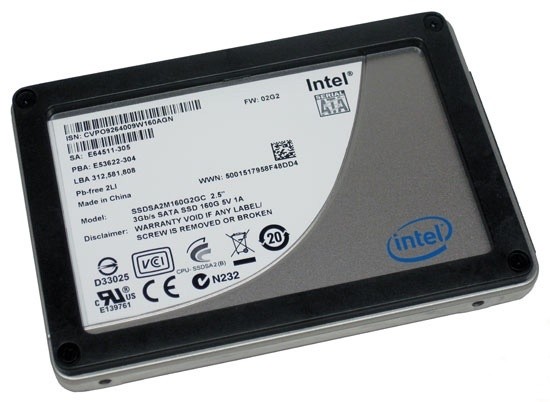
Until Marvell and SandForce released their first solid state drives Intel had a performance lead on all of their competitors. Unfortunately in our testing we found the 80GB Postville SSD lacked capacity and at the time the 160GB version cost substantially more than most consumers were willing to spend. Intel's ten channel controller was revolutionary, but forced Intel to release drives in odd capacity sizes.
A lot has changed since we last looked at the X25-M Series products. SandForce has released odd capacity sizes, 80GB being one of them. In order to do this each channel uses less flash and it has an effect on performance. Other manufacturers have also gone as far as reducing the number of active channels to achieve smaller drives, Intel being one of them. When this happens performance is lost due to the number of parallel reads and writes being reduced. At first we thought Intel had used this method to deliver a 120GB SSD, making it from a reduced channel 160GB drive, but that was not the case.
The Intel X25-M 120GB drive uses a new method to deliver different capacities, one that keeps the controller at its full channel capacity and keeps the performance very high. The new 120GB model uses five flash modules from the 160GB drive and five from the 80GB drive. In this review we will see what effect this has on performance while at the same time comparing Intel's latest SSD market entry to drives using SandForce, Marvell and Indilinx controllers.
Specifications, Pricing and Availability
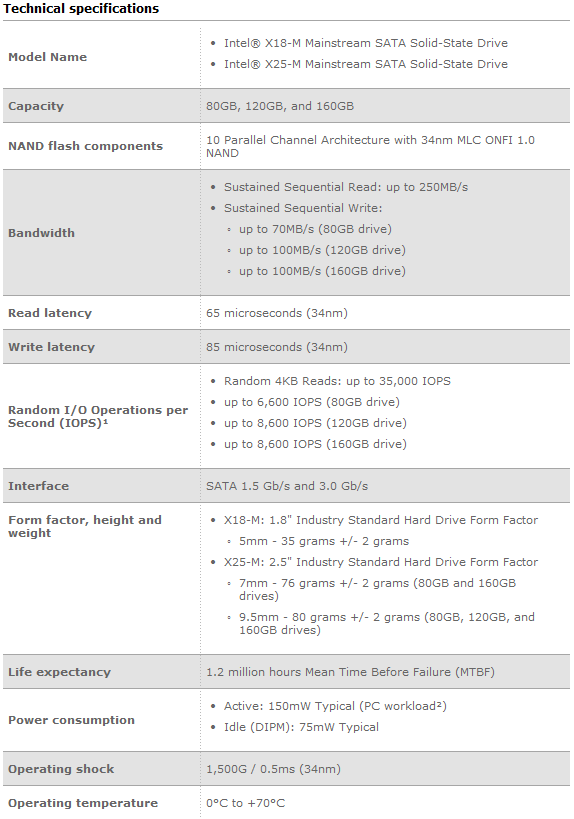
With the full 10 channel controller Intel is able to keep at minimum the same high performance found in the 80GB X25-M. Intel claims the 120GB model that we are looking at today can deliver up to 8,600 IOPS, the same as the 160GB drive, but we doubt the 120GB can deliver that level of performance across the entire range of the drive since half of the drive consists of slower, 6,600 IOPS flash. The 120GB drive still uses the same controller as the previous G2 revisions, so it is still limited to a 3Gb/s, SATA II interface.
Intel also equates the 120GB drive with the 160GB model when it comes to write speeds. Both models share the same 100MB/s write speed and all three models share the same 250MB/s read speed.
The biggest hurdle for Intel's fastest consumer drive wasn't speed or capacity, it was price. Our 120GB X25-M came directly from Newegg and was shipped in full retail trim. At the time we paid 240.00 USD for the drive and it shipped with Lost Planet 2 for free. At the time of writing (11-26-10 aka Black Friday) Newegg listed the drive at 199.00. The Lost Planet 2 special lasts until December 31st 2010.
At 240 USD the Intel X25-M was priced right in the middle of the Team SandForce 120GB pack, but at 199 it competes directly with the lowest priced 120GB SandForce drives. At the very least this puts the Intel X25-M 120GB in a good price position to compete with the very fast SandForce products on the market from several manufacturers (referred to at TweakTown as Team SandForce).
Let's take a look and see what is included with the retail X25-M SSD.
The Packaging
This was the first opportunity we've been given to examine a full retail Intel SSD. Our purchase netted up a drive with a full desktop installation kit, similar to what ships from many of the Team SandForce drives.
The most interesting side we found on the package was actually tucked away on the bottom. Here we see Intel rating their SSD lineup with the 40GB model being on the low end of the performance totem pole and the 160GB being at the top. The part that interests us is that Intel gangs the 80GB and 120GB models together with two check marks for performance, but in the specifications listed on their website lists the 120GB model with the 160GB specifications.
The back of the package shows an image of the drive and lists some of the features and benefits of solid state drives.
As with all Intel products, a full breakdown of product codes, model numbers and such is listed.
On the inside we found quite a few accessories packed into the tiny package. Intel not only ships the retail drive with a 2.5 to 3.5" desktop adapter, but also includes cables that allow you to get your system up and running quickly.
The Intel X25-M 120GB Retail
On the surface nothing has changed with the latest revision of the Intel SSD. The drive still uses a black ring to get it to the full 9mm height.
All of the label information is listed on the front of the drive and the back is bare other than the four standard mounting locations.
On the back the SATA power and data connections are where they should be for a 9mm height 2.5" form factor drive.
Here we see the screw on adapter bracket that Intel uses to turn their 7mm height drive into the 9mm model. We were hoping to be able to remove the bracket to make this the 7mm model for a netbook, but the screws used to secure the adapter are too long to be used for the conversion.
Here we get our first look at the 120GB hybrid flash drive. The row of flash on the left is labeled CAMDA, the same as used in the 160GB drive and the flash on the right is labeled JAMDA, the same as the 80GB model.
The back of the PCB has open spaces for even more flash, but none are used in the 120GB model.
Test System Setup and ATTO Baseline Performance
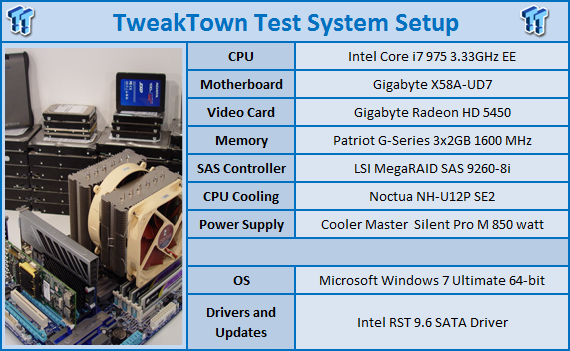
We would like to thank the following companies for supplying and supporting us with our test system hardware and equipment: AVADirect, GIGABYTE, Cooler Master, LSI and Noctua.
You can read more about TweakTown's Storage Product Testing Workstation and the procedures followed to test products in this article.
ATTO Baseline Performance
Version and / or Patch Used: 2.34
ATTO is used by many disk manufacturers to determine the read and write speeds that will be presented to customers.
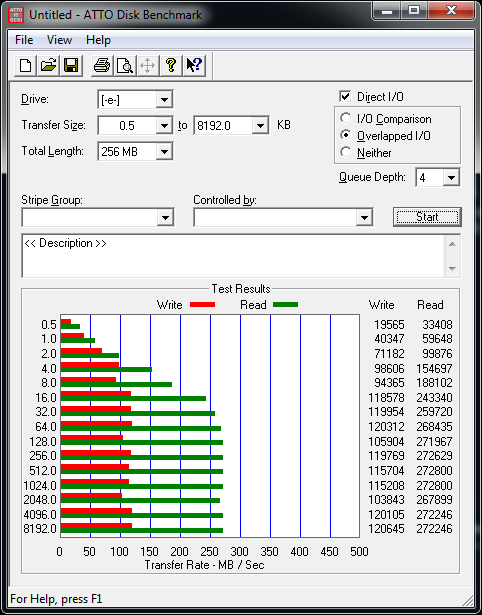
Intel rates the X25-M with a 250MB/s read speed and a 100MB/s write speed. When using the same methods as other manufacturers we found that Intel was selling their 120GB drive short.
In our testing we achieved 272MB/s read and just over 127MB/s write speeds. This is a fairly marginal increase over the 80GB G2 drive we tested previously, but still way below the 285MB/s read and 275MB/s write speeds of the SandForce SF-1200 drives.
Benchmarks - HD Tune Pro
HD Tune Pro
Version and / or Patch Used: 4.00
Developer Homepage: http://www.efdsoftware.com
Product Homepage: http://www.hdtune.com
HD Tune is a Hard Disk utility which has the following functions:
Benchmark: measures the performance
Info: shows detailed information
Health: checks the health status by using SMART
Error Scan: scans the surface for errors
Temperature display
HD Tune Pro gives us accurate read, write and access time results and for the last couple of years has been gaining popularity amongst reviewers. It is now considered a must have application for storage device testing.
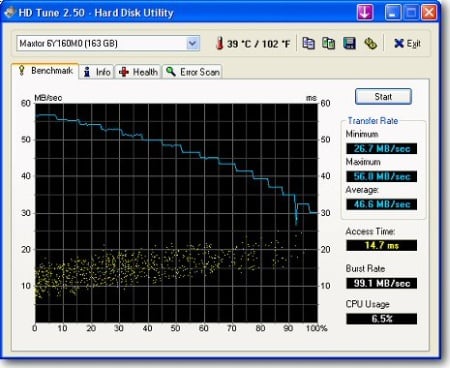
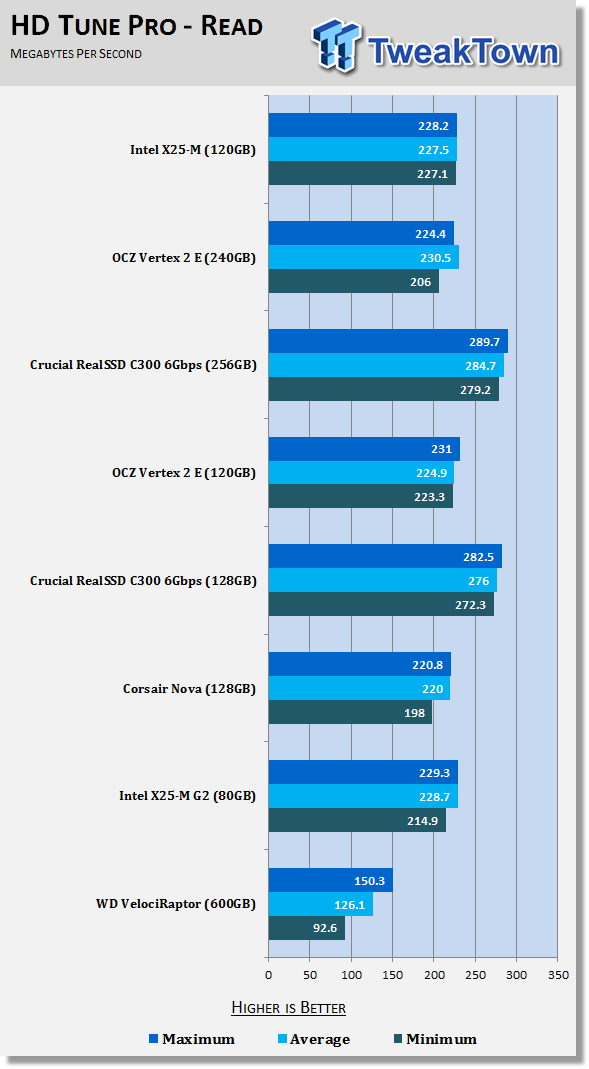
It's been a while since we tested an Intel controlled SSD, but we have been using the 80GB G2 numbers for quite some time now in our articles. The HD Tune Read Speed across the drive is nearly identical to what we encountered with the 80GB drive. Both are comparable to the OCZ Vertex 2 120GB SandForce drive, the model we will use to compare SandForce's 120GB to Intel's 120GB.
The all out read champion is still the Crucial RealSSD C300, the only SATA 6G SSD available at this time.
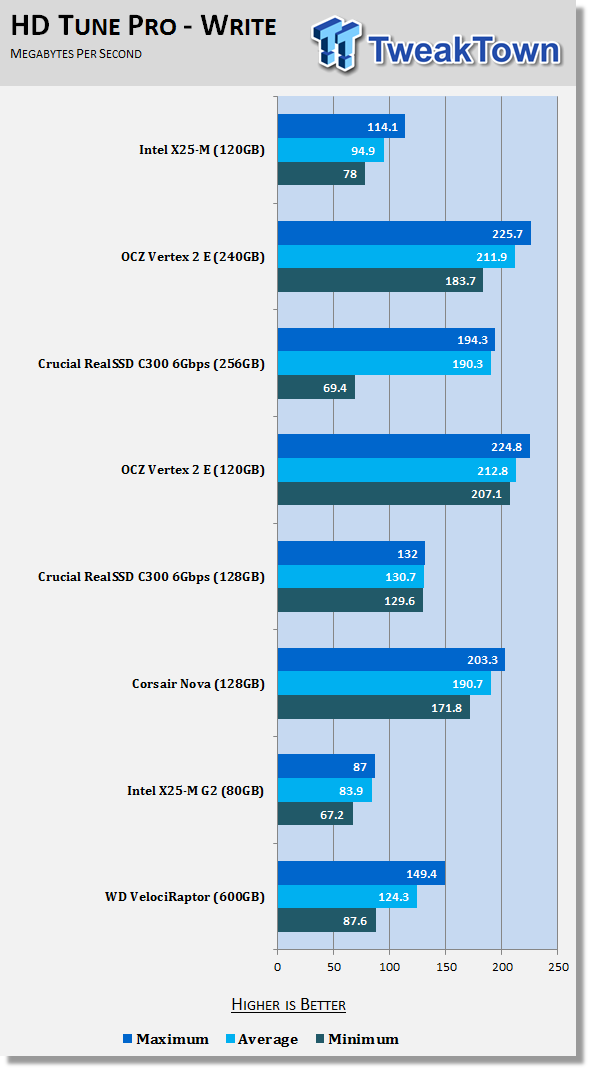
In the write speed across the drive test we see that the 120GB drive does outpace the 80GB X25-M and peaks around 114 MB/s. The average is where we like to judge drives on, though, and in that area we found an 11 MB/s difference between the two Intel models.
Overall write speeds go to SandForce, though. Here we see just over 212 MB/s average for the Vertex 2. The Crucial RealSSD C300 128GB drive isn't able to take advantage of its SATA 6G interface when writing and has a lower write speed than the 256GB model.
Benchmarks - Everest Random Access Time
Everest Random Access Time
Version and / or Patch Used: 4.60
Developer Homepage: http://www.lavalys.com
Product Homepage: http://www.lavalys.com
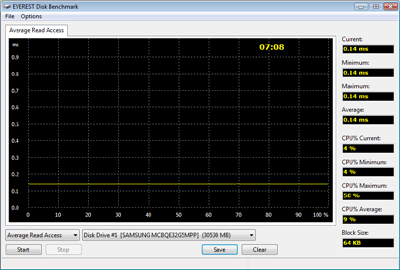
Everest Ultimate and Corporate Edition offer several different benchmarks for testing and optimizing your system or network. The Random Access test is one of very few if not only that will measure hard drives random access times in hundredths of milliseconds as oppose to tens of milliseconds.
Drives with only one or two tests displayed in write the write test mean that they have failed the test and their Maximum and possibly their Average Scores were very high after the cached fills. This usually happens only with controllers manufactured by JMicron.
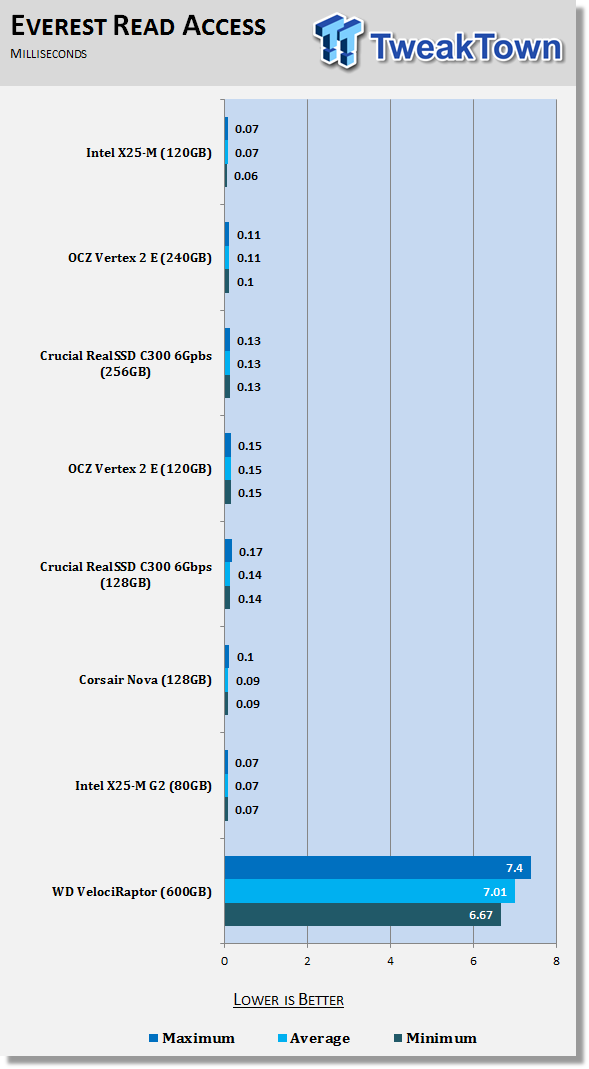
Access time is what gives solid state drives their snappy, jump to it feel. Intel has always led the way with very low read access times and the new 120GB model keeps the tradition going.
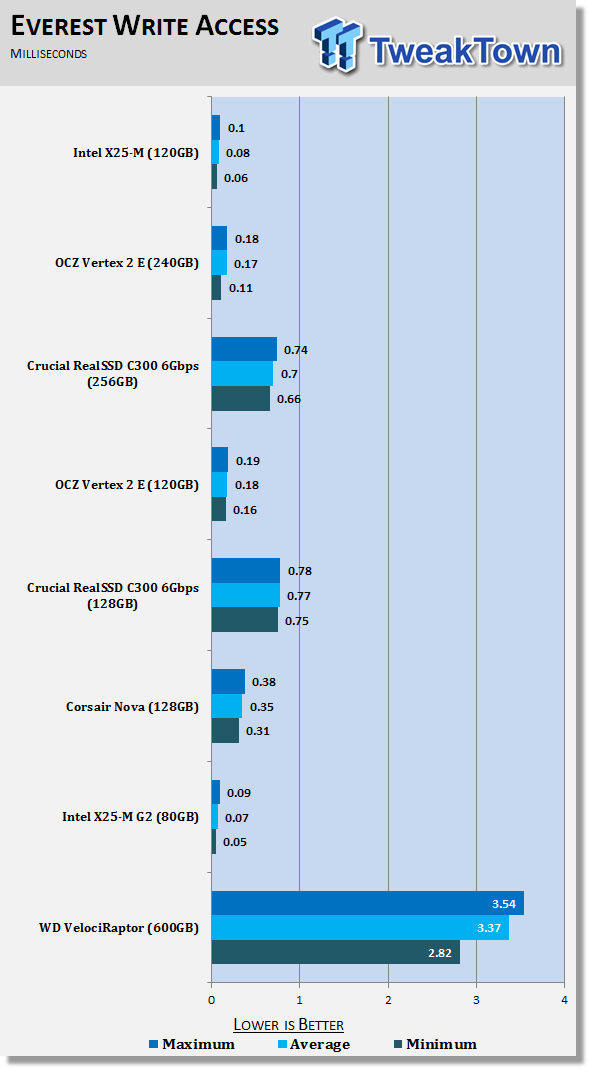
The write access times are the same for the 120GB X25-M. Here we see an average of just 8 microseconds.
Benchmarks - Crystal Disk Mark
CrystalDiskMark
Version and / or Patch Used: 3.0 Technical Preview
Developer Homepage: http://crystalmark.info
Product Homepage: http://crystalmark.info/software/CrystalDiskMark/index-e.html
Download here: http://crystaldew.info/category/software/crystaldiskmark
CrystalDiskMark is a disk benchmark software.
Key Features:-
* Sequential reads/writes
* Random 4KB/512KB reads/writes
* Text copy
* Change dialog design
* internationalization (i18n)
Note: Crystal Disk Mark 3.0 is not available to the public yet, but the Technical Preview does allow us to test 4K performance at queue depths of 4 and 32 in addition to 1. The current release Crystal Disk Mark only shows us QD 1.
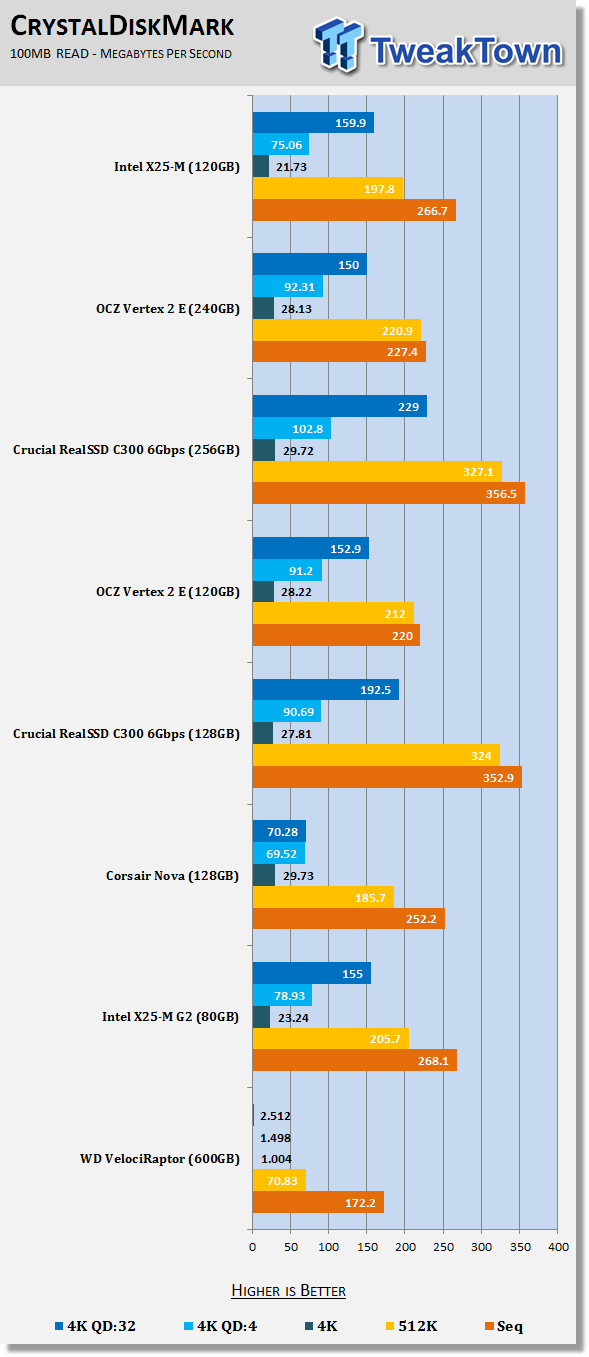
In Crystal Disk Mark we are looking at the 4K and 4K queue depth performance. Here we see the X25-M 120GB drive matching the 80GB version in read speeds, just as it should. The interesting thing is how the Intel drive compares to the SandForce and Crucial drives that on paper should be out performing the X25-M more than what they are. We'll get into the synthetic performance more in the conclusion.
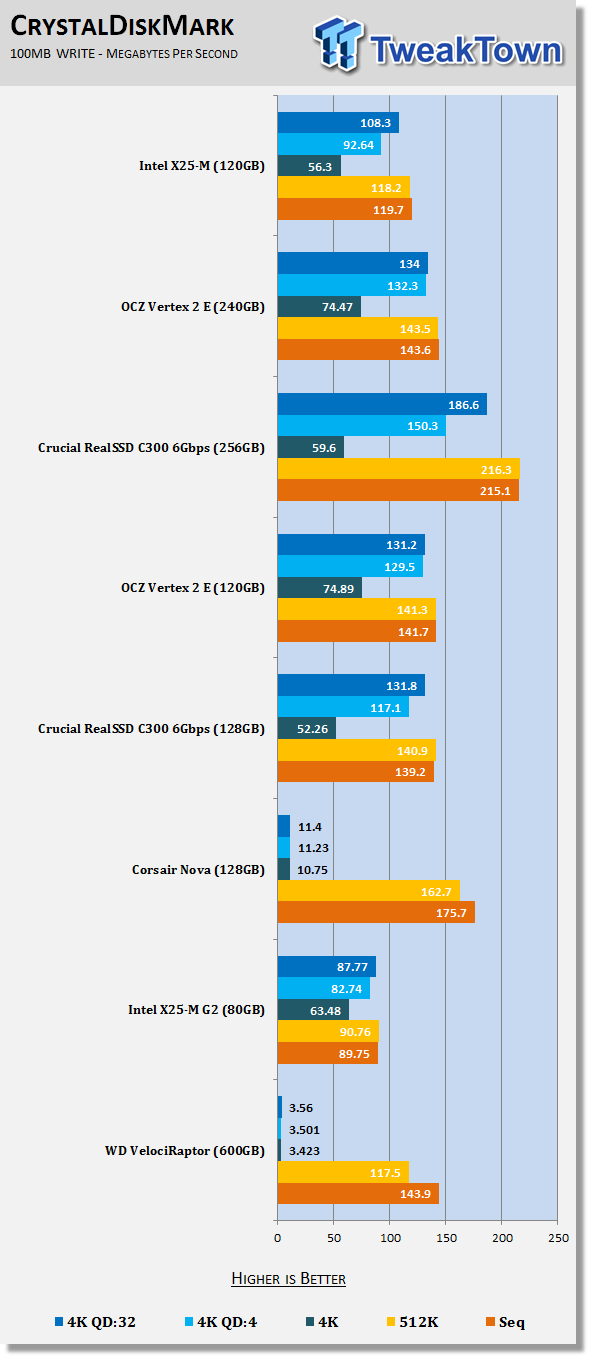
The write test shows the difference between the 80GB and 120GB drive well. Here the 120GB breaks away from the 80GB model and delivers much better performance when NCQ is used.
Benchmarks - PCMark Vantage Hard Disk Tests
PCMark Vantage - Hard Disk Tests
Version and / or Patch Used: 1.0.0
Developer Homepage: http://www.futuremark.com
Product Homepage: http://www.futuremark.com/benchmarks/pcmark-vantage/
Buy It Here

PCMark Vantage is the first objective hardware performance benchmark for PCs running 32 and 64 bit versions of Microsoft Windows Vista. PCMark Vantage is perfectly suited for benchmarking any type of Microsoft Windows Vista PC from multimedia home entertainment systems and laptops to dedicated workstations and high-end gaming rigs. Regardless of whether the benchmarker is an artist or an IT Professional, PCMark Vantage shows the user where their system soars or falls flat, and how to get the most performance possible out of their hardware. PCMark Vantage is easy enough for even the most casual enthusiast to use yet supports in-depth, professional industry grade testing.
FutureMark has developed a good set of hard disk tests for their PCMark Vantage Suite. Windows users can count on Vantage to show them how a drive will perform in normal day to day usage scenarios. For most users these are the tests that matter since many of the old hat ways to measure performance have become ineffective to measure true Windows performance.

HDD1 - Windows Defender
HDD2 - Gaming
HDD3 - Windows Photo Gallery
HDD4 - Vista Startup
HDD5 - Windows Movie Maker
HDD6 - Windows Media Center
HDD7 - Windows Media Player
HDD8 - Application Loading
The most significant tests we run for most users, those looking for a solid state boot drive, is the PCMark Vantage tests. In past articles we criticized Intel for their G2 80GB drive for poor performance in these tests. The write speed on the 80GB drive definitely impacted performance and gave the Team SandForce and Crucial drives an advantage.
The 120GB Intel X25-M looks to be another story. Where the 80GB drive was weak the new 120GB model picked up and where the 80GB model was strong the 120GB model really kicked it into high gear.
Looking at the two 120GB drives from Intel and SandForce we now see that SandForce no longer has an across the board performance advantage. The new X25-M 120GB not only caught up to the SF 120GB drive, but even manages to perform better in some tests. At this point the two 120GB drives are pretty much on equal ground as far as these typical tasks are concerned.
Benchmarks - AS SSD
AS SSD Benchmark
Version and / or Patch Used: 1.2.3577.40358
Developer Homepage: Alex Intelligent Software
Product Homepage: Alex Intelligent Software
Download here: http://www.alex-is.de/PHP/fusion/downloads.php?cat_id=4&download_id=9
AS determines the performance of Solid State Drives (SSD). The tool contains four synthetic as well as three practice tests. The synthetic tests are to determine the sequential and random read and write performance of the SSD. These tests are carried out without the use of the operating system caches.
In all synthetic tests the test file size is 1GB. AS can also determine the access time of the SSD, the access of which the drive is determined to read through the entire capacity of the SSD (Full Stroke). The write access test is only to be met with a 1 GB big test file. At the end of the tests three values for the read and write as well as the overall performance will be issued. In addition to the calculated values which are shown in MB/s, they are also represented in IO per seconds (IOPS).
Note: AS SSD is a great benchmark for many tests, but since Crystal Disk Mark covers a broader range of 4K tests and HD Tune Pro covering sequential speeds, we will only use the Copy Benchmark from AS SSD.
- Copy Benchmark
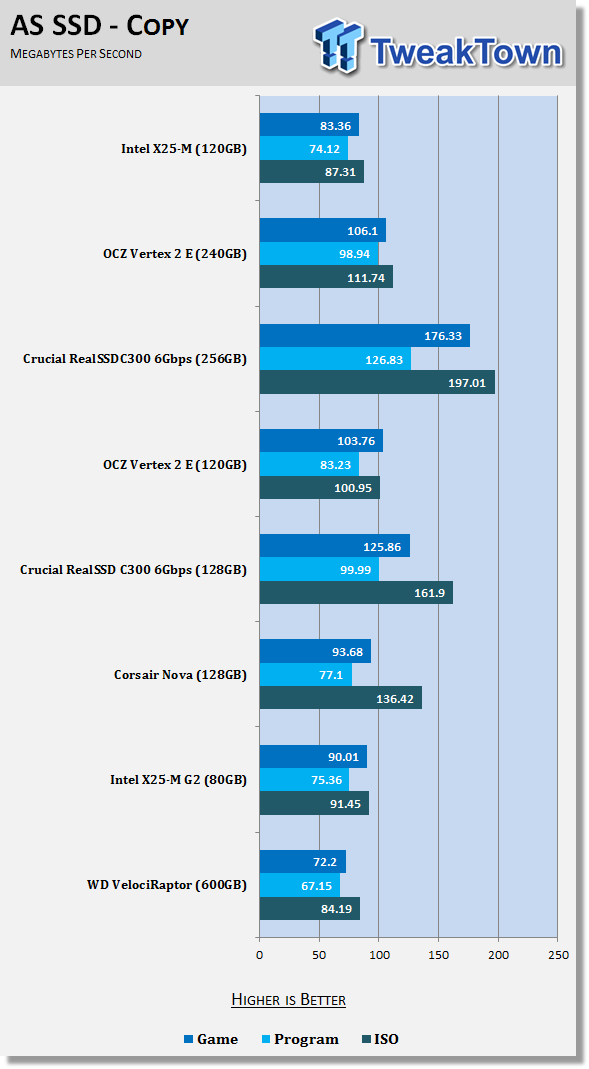
SandForce drives have a known issue when working with compressed data. The same architecture that makes them so fast with uncompressed data causes the drives to read and write compressed data slower. Because of this I was really expecting the Intel X25-M 120GB drive to perform better than the Vertex 2, but that wasn't the case.
Here we see that even with a handicap the Vertex 2, SandForce SF-1200 based drive still has an advantage when copying data to and from the drive.
Benchmarks - Passmark
Passmark Advanced Multi-User Tests
Version and / or Patch Used: 6.1
Developer Homepage: http://www.passmark.com
Test Homepage: http://www.passmark.com
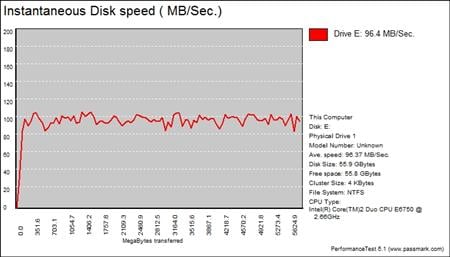
Many users complain that I/O Meter is too complicated of a benchmark to replicate results so my quest to find an alternative was started. Passmark has added several multi-user tests that measure a hard drives ability to operate in a multi-user environment.

The tests use different settings to mimic basic multi-user operations as they would play out on your server. Variances is read / write percentage as well as random / sequential reads are common in certain applications, Web Servers read nearly 100% of the time while Database Servers write a small amount of data.
The Workstation test is the only single user environment and will be similar to how you use your system at home.
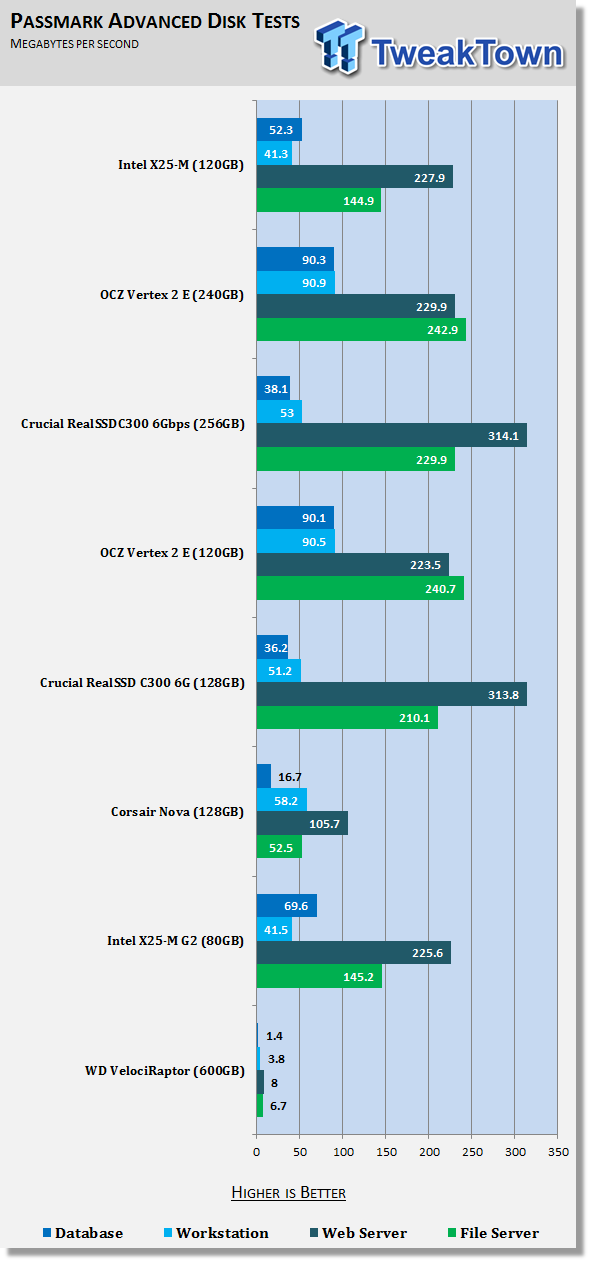
Intel makes a line of server specific solid state drives, the X25-E, and most true server environments should use the -E model. It's still always fun to run these tests to see what, if anything has changed from one drive to another.
Here we see the 80GB model outperforming the 120GB in the Database, Workstation and File Server tests. The 120GB drive does take the slight lead in the Web Server test, but only by a couple of MB per second.
Final Thoughts
The PCMark Vantage tests do a very good job showing the real world performance of solid state drives and in these we could really see just how much faster the new 120GB X25-M was compared to the 80GB model. For the most part Intel has caught up to the SandForce 120GB drives in the tasks we all use daily; the numbers are so close there are even some SandForce drives we've tested that are slower than the X25-M 120GB across the board. Daily tasks aside, the file transfer performance of the SandForce drives, something that we criticize them for at high capacities compared to the Crucial RealSSD C300, is actually faster with SandForce, so choosing where you would like the highest performance in all tests is something that buyers should consider.
The 120GB X25-M is still part of the G2 product revision and G3 is just around the corner. The last we heard G3 will be ready for retail in February, but a few were sold in China not that long ago in a gray market sale. Those drives were engineering samples and far from full retail units, but the news and published benchmarks shined some light on the status of G3. Unfortunately we still don't know with certainty what G3 prices will look like, an area Intel will more than likely improve upon.
At the time of writing the X25-M G2 80GB drive was listed at Newegg for 169.99 and the 120GB drive that we looked at today was 199.99. Given the performance increases we found today, anyone looking at the 80GB drive should spend just a little more to receive the faster model that also includes an extra 40GB of capacity. That's easily said in regards to the Intel / Intel battle, but there is still the SandForce SF-1200 competition where many manufacturers have competed to drop pricing by more than 50% off the launch prices.
When it comes to choosing an Intel or SandForce 120GB drive, it's a tough call. Both products have strong and not so strong areas. The perfect SSD has yet to hit retail. The good thing is that users now have another option when purchasing an SSD and can choose a drive based on what they would like higher performance in. When doing that you really can't call it a two drive race since SandForce has the Pro and non-Pro models (30K vs. 50K 4K IOPS) and Crucial's RealSSD C300 is also a strong contender and winner in some of the 'daily use' benchmarks as well.
When it really comes down to it, though, most users aren't going to notice a second here and a second there, especially when they are so happy just to see their PC load Windows in half the time they are used to. Users who are not looking to benchmark their computer once a week will actually be very happy with any of the top performing drives mentioned above. I could almost recommend just flipping a coin for casual users if the prices are identical, since the user experience is nearly the same when averaged together.
There is also the name factor. Intel has a very good consumer brand image and that didn't come from their bom-bom, bom-bom commercials. Intel's tech support team is likely larger than some SSD manufacturers entire staff roster and is very well trained. Casual users who may rely on tech support to get them through the drive installation will appreciate this, and if an issue arises casual users will not feel frustrated since Intel tech support works with casual users daily. The included accessory package is also the best we've seen so far and will make installation for casual users much simpler.

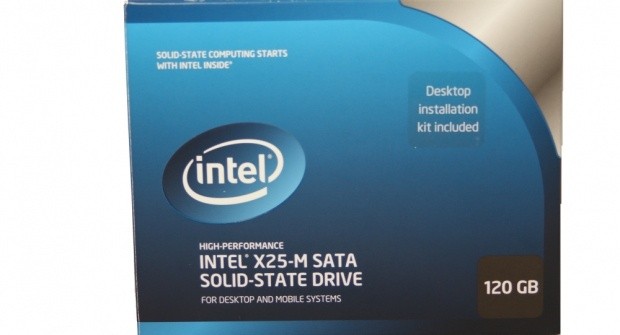

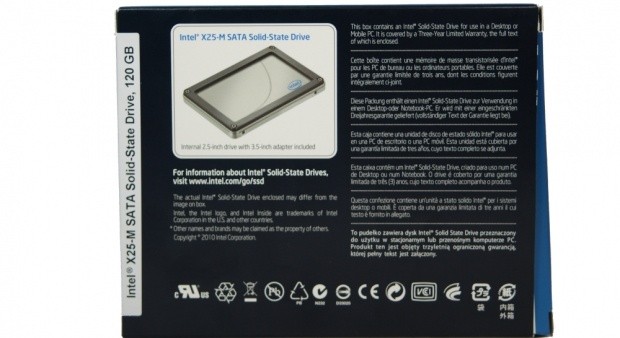
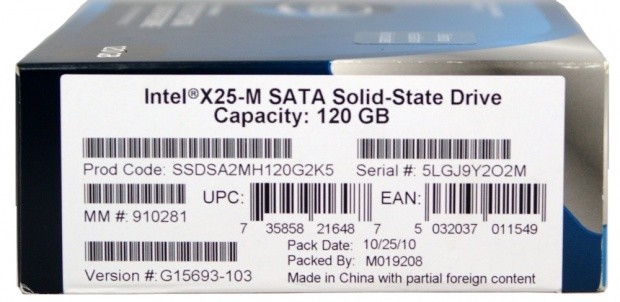
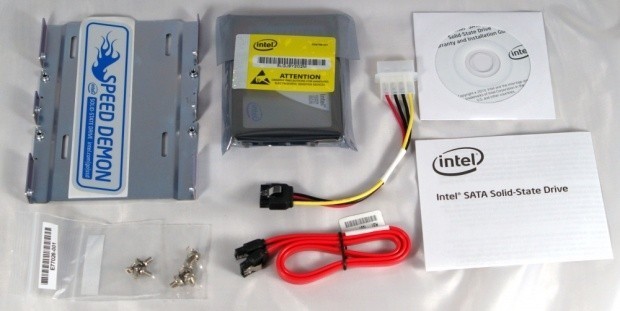
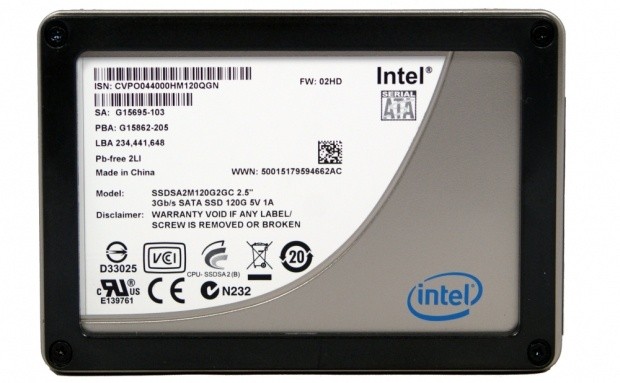
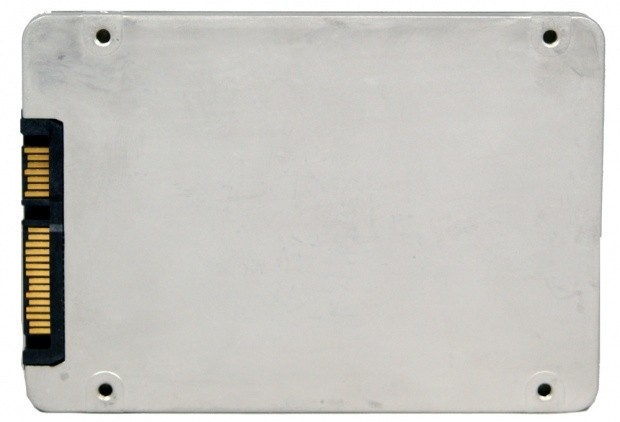


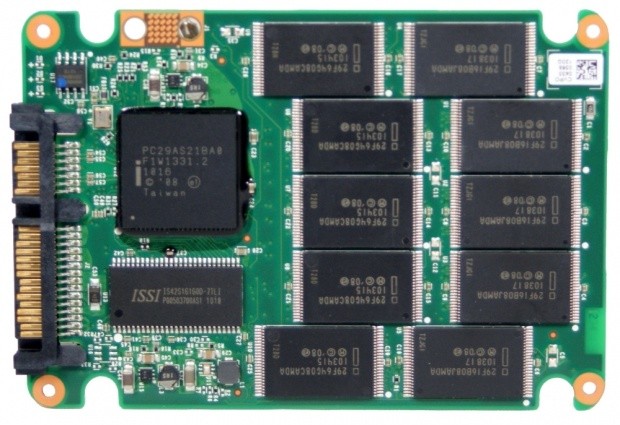
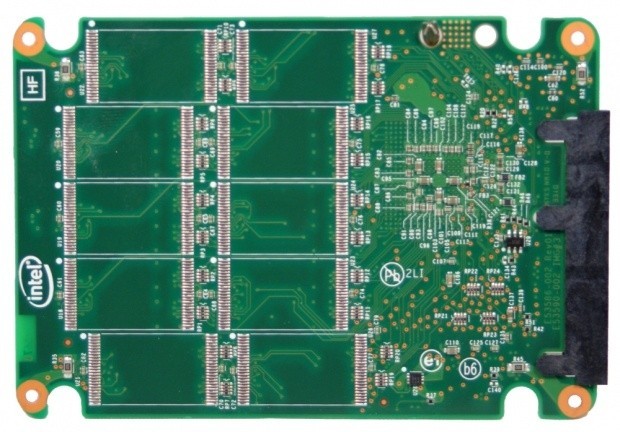

 United
States: Find other tech and computer products like this
over at
United
States: Find other tech and computer products like this
over at  United
Kingdom: Find other tech and computer products like this
over at
United
Kingdom: Find other tech and computer products like this
over at  Australia:
Find other tech and computer products like this over at
Australia:
Find other tech and computer products like this over at  Canada:
Find other tech and computer products like this over at
Canada:
Find other tech and computer products like this over at  Deutschland:
Finde andere Technik- und Computerprodukte wie dieses auf
Deutschland:
Finde andere Technik- und Computerprodukte wie dieses auf